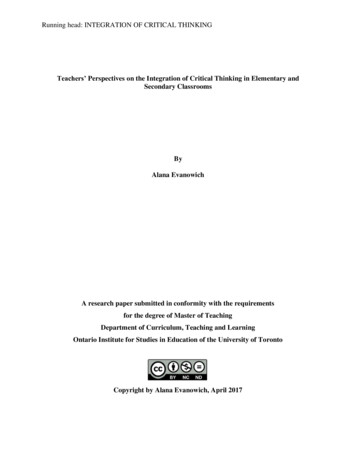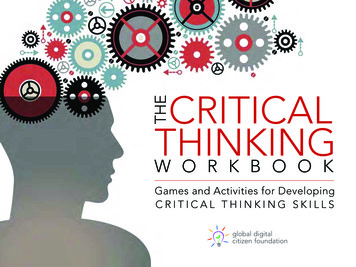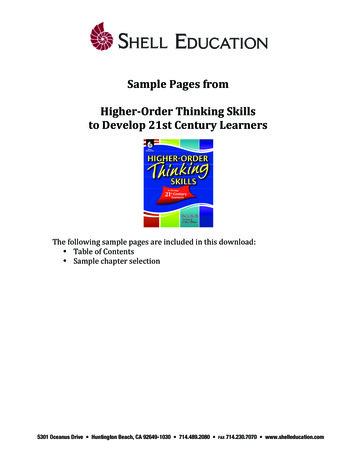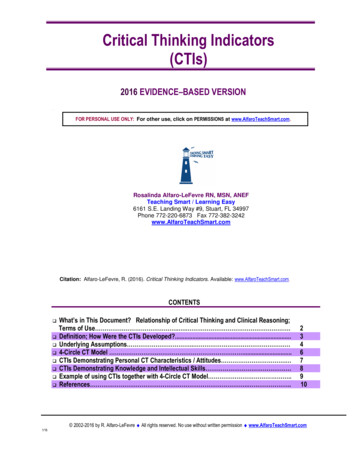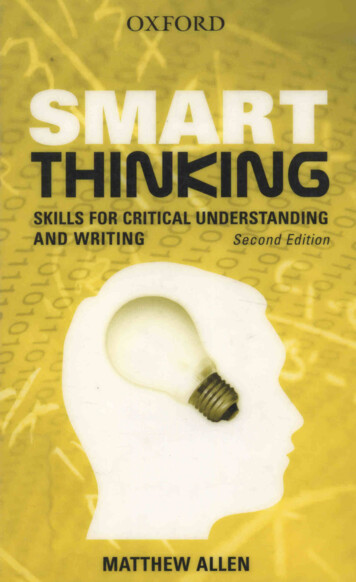
Transcription
SMARTTHINKING
ForJane and Verity (as ever)
SMARTTHINKINGSKILLS FOR CRITICAL UNDERSTANDINGAND WRITINGSecond EditionMATTHEW ALLENOXFORDUNIVERSITY P R E S S
OXFORDUNIVERSITY PRESS253 Normanby Road, South Melbourne, Victoria 3205, AustraliaOxford University Press is a department of the University of Oxford.It furthers the University's objective of excellence in research,scholarship, and education by publishing worldwide inOxford New YorkAuckland Bangkok Buenos Aires Cape Town ChennaiDar es Salaam Delhi Hong Kong Istanbul Karachi KolkataKuala Lumpur Madrid Melbourne Mexico City Mumbai NairobiSâo Paulo Shanghai Taipei Tokyo TorontoOXFORD is a trade mark of Oxford University Press in the UK and incertain other countriesCopyright Matthew Allen 1997, 2004First published 1997Reprinted 1997, 1998, 1999, 2001Second edition published 2004This book is copyright. Apart from any fair dealing for the purposesof private study, research, criticism or review as permitted underthe Copyright Act, no part may be reproduced, stored in a retrievalsystem, or transmitted, in any form or by any means, electronic,mechanical, photocopying, recording or otherwise without priorwritten permission. Enquiries to be made to Oxford University Press.Copying for educational purposesWhere copies of part or the whole of the book are made under PartVB of the Copyright Act, the law requires that prescribed proceduresbe followed. For information, contact the Copyright Agency Limited.National Library of AustraliaCataloguing-in-Publication data:Allen, Matthew, 1965-.Smart thinking: skills for critical understanding & writing.2nd ed.Bibliography.ISBN 0 19 551733 4.1. Critical thinking. 2. English language - Rhetoric. 3. Reasoning(Psychology). 4. Thought and thinking. I. Title.153.42Typeset by OUPANZSPrinted through Bookpac Production Services, Singapore
ContentsPreface to First EditionviiiPreface to Second EditionixHow to Use this Bookxi1Smart Thinking1What is smart thinking?1How do we study smart thinking?5Why do we need to 'think smart'?7Claims: The Key Elements of Reasoning9234Understanding language10More about claims14Claims and reasoning18Review22Linking: The Key Process in Reasoning25Links between claims26The analytical structure of reasoning28Learning more about the analytical structure31Review37Understanding the Links between Claims39Dependent premises39
Vi5678CONTENTSSpecial functions of premises44The link from premises to conclusion47Review53More Effective Reasoning I: Better Claims55Well-formed claims56Well-founded claims60Review67More Effective Reasoning II: Better Links69Effective use of dependent premises70Relevance74Strength of support80Review86What Kinds of Reasoning are There?89Deductive and inductive reasoning89Categorical and propositional logic92Five types of reasoning93Review100Research, Reasoning, and Analysis102Reasoning and analysis103Information understood by where we find it106Information as it relates to other information108Information classified by the topic under investigation109Information as it relates to how we are using it9111Direct and indirect sources113Review117Planning and Creating Your Reasoning120The key analytical questions121Using the analytical structure for planning127Review132
CONTENTS1 0 Bringing It All Together: Narrative and Structurevii134Example text134Casting and notes on each paragraph137Capturing the essence of the text146Overall narrative flow of the text147Summary149Answers, Discussion, and Further Advice150Glossary of Key Terms and Concepts174Further Reading186Guide to Important Skills190
Preface to First EditionThe study and teaching of critical thinking (also known as informal logic) isrelatively rare in Australia. There is little to guide the keen student or teacher in thedevelopment of skills for analysis and reasoning in everyday work and study. Theorientation of most of the available books on this subject is more traditionallylogical, and this orientation further complicates the process of teaching andlearning applied critical thinking skills, since it tends to remove the use of reasoningand logical analysis from even its most basic social contexts.Smart Thinking'is designed to provide a simple, but not simplistic, guide for thedevelopment of critical thinking and analytical skills. It combines the undoubtedstrengths of the informal logical approach with a newer—but often-overlooked—insight: that reasoning and analysis are always communicative acts. I would notpretend that one can easily resolve the epistemological tensions between, on the onehand, the commonly held commitments to objective judgment and truth thatunderpin 'logic' as a mode of analysis and, on the other, the social relativism andintersubjectivity that a communicative-theory approach demands. However, froma pragmatic point of view, there is considerable profit to be gained from lettingthese two distinct approaches jostle alongside one another. Moreover, for all myattempts to keep competing epistemological ideas to a minimum in SmartThinking, the book cannot remain purely 'practical'. Simple advice on 'betterthinking' rubs up against deep and important matters of philosophy in a way that,I hope, creates a constructive interaction between the ease with which one canbegin to improve one's thinking and the complexity of thinking about smartthinking.While I myself work theoretically within post-structuralist frameworks, SmartThinkings bias towards communicative issues stems primarily from the verypractical experiences I had in developing and teaching a critical thinking unit(Applied Reasoning 200) at Curtin University of Technology in Perth. On the basisof my experiences with many hundreds of students, I am confident in asserting thatit is wrong to divorce analytical thinking from its communicative context. Outsidethe narrow confines of some academic disciplines, communication takes place on aVIII
PREFACE TO FIRST EDITIONixvast scale, with far too little critical analysis to support it. It is precisely at thejunction between 'knowledge as something one knows' and 'knowledge as afunction of communication' that most of us need assistance in sharpening up ourthinking skills.My work in Applied Reasoning 200 has not only helped my own developmentas a critical thinker but has given me the opportunity to test ideas and approacheson a captive audience. So, my first debt of gratitude is to all the students who have,in so many ways, contributed to the writing of this book. Applied Reasoning 200also became the focal point for a series of collegia! relationships from which I havebenefited enormously. For their assistance, insights (and perseverance with oftenimpractical ideas), my thanks are extended to Patrick Bertola, Gina Koczberski,Des Thornton, and especially, Eamon Murphy, all of Curtin University. Thanksalso to Will Christensen, Dennis Taylor, and Roy Jones for their positiveencouragement as heads of academic departments. I also owe a debt of gratitude toRichard Bosworth, who some years ago, when I began to study at university, firsttaught me that critical enquiry involves asking about the 'who', 'when', 'why', and'how', as well as the 'what' that was the staple of high school study. Michelle Forsterand Emma Rooksby provided invaluable research assistance and general help; bothare fine young philosophers. Thanks, as well, to my publisher, Jill Lane, and editor,Lucy Davison, of Oxford University Press. Finally, I could not have written thisbook without the unstinting support and reassurance of my wife Jane and stepdaughter Verity; most of all, they remind me that a person cannot live on logicalone and confirm in my mind that life must be lived, not just with analyticalreserve, but also with passion and commitment.Matthew AllenPerthSeptember 1996Preface to Second EditionI have been fortunate enough to find that I was right to assume that a practicalbook on critical thinking skills set in the context of communication would be bothpopular and necessary. I continue to be involved in teaching critical thinking in theunit Applied Reasoning, which is now a part of some courses of study throughOpen Learning Australia (REAl 1—visit http://www.ola.edu.au), and is beingrevived on campus at Curtin University. I have also realised that, in writing SmartThinking, I myself learnt as much as I would hope for its readers and so, in the end,it was an easy decision to produce a new edition.This second edition reflects the experiences of teaching with Smart Thinkingover the years since it was first published. In revising it, I have found that much ofwhat I had originally written remains valuable, and that students have learnt from
xPREFACE TO SECOND EDITIONit. But I have also made some significant changes, including greater assistance inthe earlier chapters to help readers with the more complicated skills and concepts,as well as expanding later chapters on reasoning and on research. The final chapteris now a fully worked example of the skills that underpin the whole book, providinga model for readers of the power and value of the approach I am outlining. I wouldhope that readers will now find the sometimes-confusing journey towards greaterability in critical thinking and reasoning just that little bit easier, and with a clearergoal ahead.In writing the second edition, I have been aided greatly by Jane Mummery andRobyn Mayes, both fine teachers of critical thinking, who have struggled with theproblems of the first edition in teaching Applied Reasoning and have generouslyprovided advice on how I might improve it. To them both, I owe a great deal. I alsowish to thank Christine Richardson with whom I taught elements of criticalthinking and who gave me the opportunity to develop further my ideas aboutreasoning and research. To my long-suffering publishers at Oxford University Press,especially my editors Lucy McLoughlin, Anne Mulvaney, and Chris Wyness, greatthanks and apologies for all the delays. Perhaps they could ask the governmentabout its neglect of higher education and the consequent doubling of workloadssince I wrote the first edition. And to Jane and Verity, this book is still and alwaysfor you both.Matthew Allenm.allen@curtln.edu.auPerthFebruary 2003
How to Use this BookTo get the most out of this book, you will need to read it carefully chapter bychapter. The book builds sequentially, so that many of the ideas and conceptsintroduced in earlier chapters underpin more complex discussion of related issuesin subsequent chapters. Also, as you go, you should do the exercises in each chapter.Do not check the answers until you have completed all of a particular exercise andare satisfied with them. When you turn to the Answers, Discussion, and FurtherAdvice, you will see that, in most cases, there is further discussion of the issues andconcepts relevant to each exercise. As much as you can, don't be tempted to look atthe next set of answers until you have completed the exercises for them. Often, youwill be asked to do an exercise in order to provide you with the experience necessary to get the most out of the further advice offered in the answers. And, when youhave done the exercises and checked the answers, I expect you will need to rereadand revise the chapter again.After you have read a chapter, done the exercises, and checked the answers, lookat the Concept Check and Review Exercise at the end of the chapter. The conceptsintroduced in each chapter are listed. You should briefly write down what youknow about them, then turn to the Glossary to check your answers. There are, bycontrast, no answers provided for the review questions that you will find at the endof most chapters. If you have understood and integrated the material in eachchapter, you should be able to answer these questions confidently. If you cannot,then it is probably a sign that you have missed something.Finally, you should integrate what you learn about reasoning in this book withthe work or study you are doing at the moment. For example, when doing theexercises and review questions, you will often be called upon to use informationfrom your own life as examples or basic material with which to do an exercise. Thewhole point of this book is to give practical, applied advice. I can provide theadvice; you must apply it.This book aims to provide you with structured information, exercises, andreflections to guide your own learning. Your investment of time and effort inworking through this structure will provide you with considerable returns inimproving your smart thinking.XI
1Smart ThinkingThere is an inner logic, and we're taught to stay far from itIt is simple and elegant, but it's cruel and antitheticAnd there's no effort to reveal it .Bad Religion, 'Inner Logic'What is smart thinking?There are many words associated with what is, loosely, termed 'thinking'. Weare often told to 'think about the issues', to 'analyse in more depth', to 'usereasoning', or to 'be rational'. Sometimes (perhaps with reference to computers,or to the legendary Star Trek character Mr Spock) we are told to 'be logical'.Often students are told that they must think 'critically' if they are to succeed.When people write essays or reports, they are usually advised to make sure thatthey have a good 'argument' or that they 'explain in detail'. But do students(and lecturers) really know what these words and phrases mean? Can weactually identify the key skills and underlying techniques that allow us to thinkbetter?The answer is yes. Smart thinking means.knowing how to: work out and express your main ideasplan your communication of ideas so that they can be clearly understoodcheck to see if you have covered all the important parts of your topic1
2 SMART THINKING: SKILLS FOR CRITICAL UNDERSTANDING & WRITINGestablish a framework or structure in which your basic facts and evidencemake sense present ideas by linking them together to convince readers of your conclusion.Moreover, we must also relate thinking to knowledge and information (what wethink about), and the processes of communicating our ideas, either in written ororal form. Thinking is one aspect of an integrated process of finding, analysing, andcommunicating information. Your thinking begins even when you are deciding'what' to read and write about.'Smart thinking' can assist you in: working out where and how to look for the information you need understanding that information in relation to your own work deciding which information is relevant to your topic and which is not identifying when you need to find out more information to make sense of aproblem.Smart thinking can also improve your capacity to set your communication incontext. It alerts you to the importance of: your audience and their expectations of what you are doingthe requirements upon you to communicate in a certain way in a certainsituation your own assumptions and biases, and the role of society in forming thosebiases, whichwill need tobe considered and exploredthrough yourcommunication.To think smart, you must use reasoning. Reasoning is the basis of much of ourthinking. It is often described simply as the process of thinking through andcommunicating our reasons for holding certain views or conclusions. Reasoning is,however, better defined as a process of understanding and exploring the relationships between the many events, objects, and ideas in our world. None of theseindividual 'items' can be meaningful in and of itself. An item can only beunderstood in relation to other ones. Reasoning enables us to get beyond a worldof innumerable separate events, objects, and ideas. Using reasoning, we see that allthese separate items are interconnected, and what we know about any particularobject depends on our knowledge of other objects. Sometimes the connections areobvious; other times, they are much harder to see. Reasoning involves finding andexpressing these connections or relationships so that each individual event, object,or idea is explicable in terms of other events, objects, or ideas.Exercise 1 . 1Smart thinking demands that we do more than just 'think' vaguely about things.Before we look at reasoning, the key underlying process of thinking, let's considersome common 'informal' ideas about thinking. Look at the four actions listed
SMART THINKING3below and, writing on a piece of paper, list some examples in your own life ofwhen you have successfully done these actions and why you did them. Theanswers contain more discussion of each one. 2 Ask questions (of ourselves and others) Seek out information Make connections Interpret and evaluateReasoningReasoning represents one of the great advances that human beings have made intheir ability to understand and make sense of the world. It has been described as a'complex weave of abilities that help you get someone else's point, explain acomplicated idea, generate reasons for your viewpoints, evaluate the reasons givenby others, decide what information to accept or reject, see the pros as well as thecons and so forth'.3 Yet it is also the case that reasoning does not come naturally butmust be learnt and can be improved.Let us begin with an easy example. Imagine you hold an apple in one hand andan orange in the other. Now, at first sight, these two objects appear to be completelydifferent; each would seem to be understandable only in its own terms—that is, ina way unique to each apple and each orange. However, we are better able tounderstand them and to communicate what we think about them when we start tomake connections. Here are some examples: An apple is not an orange. An apple and an orange are similar: both are pieces of fruit. This apple will be, roughly speaking, the same as all the other applesI have eaten. If I eat this orange and I like the taste, then I can assume thatgenerally I will like the taste of other oranges. You should eat this fruit because you are hungry.Obviously, this list makes only a few simple connections between the twoparticular pieces of fruit that we are considering; it also makes a few connectionsbetween the orange and the apple and other pieces of fruit generally; and the latterconnections relate fruit to people.If we did not make these connections, then every time we ate an orange, forexample, it would be a new experience. We would not be able to rely on pastexperience or on our experiences with other things; nor would we be able to makeany predictions about future experience. Such a world might be interesting (as eachmorning you drank your orange juice and had a whole new experience), but itwould also be extremely confusing. Moreover, if you think about a more complexexample (say, deciding to study for a university degree) you can see that, withoutthe ability to make connections between things, you would not be able to make
4SMART THINKING: SKILLS FOR CRITICAL UNDERSTANDING & WRITINGyour decision in the way that all of us take for granted (by thinking, for example,'A university degree will help me get a better job'). When we start to make connections, we are able to know things of which we have no direct experience (andwhich may not yet have happened). Of course, since we live in a society in whichreasoning is accepted as the main method of processing information, we already usereasoning, but we usually do not think about it.Often, we can feel reasonably certain about our knowledge because it is basedon evidence of things that we do know about. For example:In the past, when driving down the freeway after work, I have found thatthere is usually a traffic jam. Because of the traffic jam, it always takes along time to get home. So, today, because I need to get home quickly, Ihad better leave work earlier.The conclusion that 'I had better leave work earlier' follows from the evidenceor reasons given for it. We can say that it is a 'reasonable' conclusion. Usingreasoning requires us to look for and rely on structures of connections betweenseparate things or events in the world; it also requires us to make an active effort tocreate these structures—to make the connections that we cannot easily see.The two main kinds of relationships that underpin these structures are: how things relate to one another, at any given moment (syntagmatic relationships such as 'an orange is a citrus fruit' or 'citrus fruits are edible')how things relate to one another, over time (paradigmatic relationships suchas 'eating too many oranges made me feel sick' or 'if I want vitamin C, then Ishould eat an orange').Working out the precise relationship requires attention to a number of'patterns' that might help us to see how one thing is linked to another. Thesepatterns can be understood through concepts such as: similarity/difference commonality/inconsistency necessity and sufficiency.When we make these connections, we are able to function much moreeffectively and to make sense of the world around us. In particular, we are morecapable of communicating our ideas and discussing knowledge with otherpeople.The things, then, that we do with reasoning, as a form of communication, are: arguing ('You should not believe what you see on television because . ') 4explaining ('Digital television has been introduced because . ')making decisions CI think we should buy a digital television receiver because. ')predicting the future ('I expect digital television to make pay television betterbecause . ')exploring issues ('How will digital television link to the Internet?')
SMART THINKING 5finding answers ('Why did the government decide on a higher-quality digitaltelevision standard?') justifying actions ('When first introduced, I thought subscribing to pay television was not a good idea because . ' ) .So, smart thinking is about reasoning, which is about the use and communication of knowledge. Researching, reading, analysing, testing, checking, planning,and writing all depend on understanding those interrelationships. Once youunderstand that knowledge consists of innumerable interrelations between small'bits' of information, then you will be able to find, shape, and use knowledge foryourself.But reasoning is also about people: the authors and audiences of arguments,explanations, and so on. And it is in relation to the human, social aspect ofreasoning that we must really be 'smart'. Reasoning is not just formal logic; nor isit an abstract way of thinking about ideas. It is always a social act. People always usereasoning for particular purposes (be they economic, political, or whatever). Theyall have different perspectives on the issues being debated. Their age, class, race,gender, and ethnicity all influence the broad structures upon which they rely inreasoning. If we forget that reasoning has this social aspect, then we will run therisk of failing to think effectively (this point will be explored in more detail in laterchapters). The connections and relations between ideas, events, proposals, and soon only become meaningful in the context of how, when, where, and why they arecommunicated with others.How do we study smart thinking?Thinking about thinkingReasoning is something we already do: all of us have learnt, in one way or another,to think and to reason, to make connections and see relationships between variousevents and attitudes in our world. So, being a smart thinker is not about becominga different sort of person, but about improving skills that you already have. The wayto achieve this goal (and the main emphasis within this book) is to become explicitly aware of the analytical processes involved in reasoning. If you do, then you willbe able to analyse complex issues more deeply, understand and process informationmore effectively, and communicate your ideas convincingly.In succeeding chapters, then, we will learn a way of talking and thinking aboutreasoning that allows us to understand and use reasoning better. In particular, wewill learn about the 'analytical structure' of ideas, which is, essentially, the clearestexpression of reasoning. However, we usually encounter such structures 'embedded'in the words we read and hear, or in so-called 'natural language'. We must learn todistinguish more effectively between the structures and the natural languagethrough which it comes to us. We will also encounter the idea of 'analyticalquestions', which can guide the way we think about and develop the relationshipsthat comprise our analytical structures.
6SMART THINKING: SKILLS FOR CRITICAL UNDERSTANDING & WRITINGThinkers with attitudeRemember, smart thinking always has a social dimension: we humans are doing thereasoning. As a result, one of the key ingredients of successful thinking and analysis,and of the effective use of reasoning, is our own attitude. For most (if not all) of us,our knowledge will usually consist of both the basic information or 'facts' we know,as well as a framework or structure of broader ideas with which we interpret thesefacts. Many of us are quite capable of assimilating and 'knowing' the facts, butsmart thinkers constantly assess their structures and frameworks. In the process,they develop a much deeper and more effective appreciation of situations andevents. Smart thinkers can be confident in their reasoning, precisely because theydo not rely on too many unexamined or unquestioned assumptions.First of all, we should always be willing to reflect on our own views andpositions—to scrutinise the way we think about the world. We might ask ourselves,from time to time: Are my views consistent with one another? What assumptions underpin my views? Am I open to new ideas and alternative conclusions? Can I look at this issue from another perspective?We should also be constantly asking ourselves, in relation to the issues thatmatter to us: Why did this happen? What should we do next? What does it mean?As we will see, questioning is the key analytical skill that enables us to developcomplex knowledge about the world in the form of structures of related ideas, so asto communicate with other people.It is not the answers to these questions that matter, but the very fact that we askthem of ourselves, the willingness not to 'take things for granted' or to be satisfiedwith the 'obvious answer'. Indeed, a great failure of our society is that, by and large,we are people who believe that someone has the answer and all we have to do isdevelop a clever way of finding that answer. In fact, the key skill that you need, tobe an effective and thoughtful adult who is able to engage with and understand theworld, is not an ability to find the answers: it is the ability to ask the right questions.If you can ask the right questions, then most of the answers will come very easily.Moreover, you will also be able to determine why others do not necessarily acceptyour answers but have their own views. Questions are fundamental to reasoning.Exercise 1.2On a piece of paper, write down a key issue that you are dealing with at themoment—at work, perhaps an assignment, or something significant to you; don't
SMART THINKING7choose a matter that is personal and emotional since these are often bestanalysed in different ways. Then start to ask yourself, in your mind, questions thatwill help to analyse that issue. As you go, write them down on the page, reviewthem, and add more questions. Try to ask questions that are prompted by the firstquestions you thought of, questions that 'connect' the dots between the issue andanother question.Why do we need to 'think smart'?Basically, unless we are smart thinkers, we cannot understand the world as well aswe should; we cannot solve problems effectively and consistently; we cannot besuccessful in the areas of our life that concern information. Knowledge is the 'stuffof everyday life in the early twenty-first century. We are always being asked to findit out, develop it, communicate it, and think about it. Smart thinking improves theways in which we can work with knowledge and information.First of all, smart thinking helps you to study. All academic work requires the useof reasoning. You want to understand the content, to digest information, pick outthe key issues to learn, grasp the underlying concepts, and come to terms with unfamiliar ideas: reasoning is the way to go. Most teachers look for reasoned explanations and arguments when marking assignments. More importantly, by usingsmart-thinking skills to understand context—the situations in which we learn andcommunicate knowledge—you can understand the system you are in, the expectations and requirements on you as students, and then fulfil those requirements.Second, smart thinking helps you at work. Work is, by and large, about decisionmaking. It involves initiating change, coping with new and unfamiliar situations,finding better ways of doing things, finding out crucial information, understandingthe people and institutions you work with, and solving complex problems. You usereasoning to accomplish these tasks, and if you have smartened up your thinking,then you will have more confidence in your abilities and succeed more often. Inparticular, the insights gained through smart thinking will assist in promoting moreeffective communication. Such communication is essential to successful businessand professional life.Third, and perhaps most importantly, smart thinking makes you an activemember of communities. We are all members of various local and national groupsand communities. While our membership of these communities gives us certainrights (for example, the rights of citizenship), it also entails certain responsibilities.It is our responsibility to understand what is happening in society and to act wherenecessary to conserve or change, to get involved, to make things better, and to fightinjustice. We can only pick our way through the complex tangle of opinions, assertions, ideas, and assumptions that make up the dominant social world in which welive /fwe use the skills of smart thinking. Otherwise we are just going to be swe
Thinking, the book cannot remain purely 'practical' 'bette. Simplr e advice on thinking' rubs up agains deet p and important matter philosophs of y in a way that, I hope, creates a constructive interaction betwee with whicnh th onee eas can e begin to improve one's thinking and the complexity of



